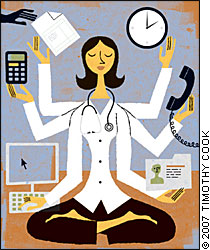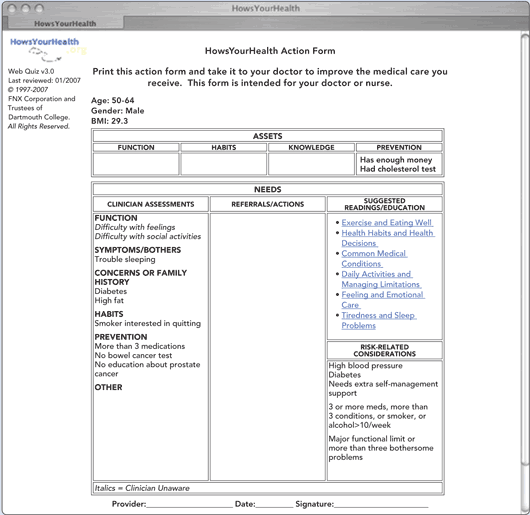
Simple, low-cost technologies and strategic outsourcing have helped this solo physician practice efficiently, even without any staff.
Fam Pract Manag. 2007;14(8):27-30
Dr. Ho is a solo family physician in North Kingstown, R.I. Author disclosure: nothing to disclose.

I opened a solo family medicine practice in Rhode Island in October of 2004. It's an ultra-solo, no-staff ideal medical practice, also known as a micro practice. Low overhead allows me to see fewer patients per day and spend more time with them, but it also requires that I optimize efficiency in order to accomplish all of the administrative tasks on my own.
Before opening my solo practice, I worked as a salaried family doctor for more than 13 years in an environment where I was completely sheltered from the practice management aspect of medicine. Although I wondered whether I would be able to manage the challenges of running my own practice, I was inspired to make the leap after reading about Dr. Gordon Moore's ideal micro practice in Family Practice Management1,2 and watching a colleague of mine set up a similar practice that has prospered.
The start-up process was relatively easy: I applied for insurance provider numbers, rented some office space, incorporated myself, bought used office equipment from a retiring physician, created a practice Web site (http://nkfp.familydoctors.net) via Medfusion (http://www.medfusion.net) and placed an advertisement in the local newspaper.
Believing that technology is a key to efficient practice management, I also decided to purchase an electronic health record (EHR) system (Amazing Charts; http://www.amazingcharts.com) and billing software (EZClaim; http://www.ezclaim.com) that interfaced with my EHR. (Total cost for hardware and software at the time of purchase was less than $4,000.) To supplement my income while I developed my practice, I found a part-time job for 12 hours a week at a college health service. Then, in October 2004, I opened the door to my office with a few patients (fewer than 10) who followed me from my previous practice.
Hook, line and sinker, I had swallowed the ideal medical practice bait. I was and remain convinced that ideal medical practices can deliver what patients want and need through the medium of a sustainable and enjoyable practice setting for physicians. However, at the 18-month mark of my new practice, I noticed that although my practice engaged me and provided a level of professional satisfaction that my previous employment had not, I was spending way too much time on my work. I was routinely bringing home billing and notes that had not been finished and phone messages that had not been attended to. Burnout was imminent.
It was clear I needed to fix a number of key workflow processes to achieve greater efficiency in my practice.
Seven interventions
From June to December of 2006, I tested and implemented a number of solutions to hone my office efficiency. Through this process, I discovered one of the most delightful aspects of a micro practice: its responsiveness to change. When I decide to change something, it simply gets done. No one needs to be convinced or trained. The results are immediate and dramatic.
I've listed below the changes that were the most helpful in my workflow redesign:
1. Offer online appointment booking. I use http://www.appointmentquest.com for $14.75 per month. Now, when patients want to make an appointment, they simply go to my Web site and follow the prompts. I am gradually training my patients to use the system as I see them, or while they are on the phone with me. After I go through the steps with them once, they realize it is easy, efficient and convenient, and they take over. It saves them and me lots of phone time.
2. Delegate history-taking to patients. In September 2006, I started using Instant Medical History (http://www.medicalhistory.com), which allows patients to enter their own history into their chart. I use both a Web-based version that patients can complete from home and an office-based version that patients can complete in the waiting room. To implement this, I had to rearrange my office and set up a desktop computer for patient use, but it was worth the effort. More than 80 percent of my patients participate. The system has many benefits. It produces a more complete note than I would have, which allows me to bill at a higher level than I might otherwise be able to; saves me time; helps patients think about the reason(s) for their visit before they see me; keeps churning out histories of the same quality even at the end of the day when I am fatigued; has made obsolete all the paper rating scales I used to use to evaluate patients' pain, depression, etc.; and helps me finish the note in the exam room. Plus, at $50 a month, it's much cheaper than a nurse or medical assistant. (For more information on this topic, see “Improving Care With an Automated Patient History,” FPM, July/August 2007.)
3. Use free tools to measure how you're doing. How's Your Health? (http://www.howsyourhealth.org) is a free online tool that collects patient-entered data regarding their health status and their perceptions of the care they have received, and it provides a summary to the patient and to the doctor. I can even export the data electronically into Doc-Site (http://www.docsite.com), a Web-based patient registry that helps me track and manage patients' chronic, complex and preventive health needs. Patients can complete the HowsYourHealth.org survey at home or on the computer in my waiting room. It gives me an instant practice database that helps me identify my patients' needs and measure how I'm doing.
4. Use e-mail to convey laboratory and X-ray results to patients. E-mailing provides a written record to the patient, is fast (particularly if you use templates) and is free, assuming you already have e-mail set up in your practice. I also use Updox document management software (http://www.updox.com), which allows me to attach items such as lab orders, prescriptions and even Web pages and save the information to the patient's EHR file as I'm sending the e-mail.
This approach is much more efficient than traditional communication methods. Conveying results by mail is neither fast nor free. Calling patients with their lab results often sets you up for, “Oh, by the way, doctor, I wanted to ask you about [insert any new problem],” which can consume your time.
5. Don't be afraid to let the answering machine pick up. During office hours, my message machine states, “I am currently with a patient or otherwise unable to get to the phone; please leave a message and I will call you back as soon as I can.” Interrupting the work I am currently engaged in is highly inefficient, whereas handling messages at a time of my choosing is much more effective. Because I return calls promptly, patients don't object.
6. Use electronic billing. Electronic billing through a clearinghouse is easier and faster than paper billing, and the clearinghouse scrubs my claims and identifies those with problems. (I use EClaims, http://www.eclaims.com, which costs about $65 per month after setup.) The “easy” rejections can be fixed in a day or two, as opposed to disappearing into my accounts receivables. Electronic billing also provides proof of the date of submission, which I didn't have with my paper system, and electronic remittance advice, which makes it easier to produce the explanation of benefits in question when arguing with insurance companies about payments.
7. Hire a poster/biller. I gave up on the pure ultra-solo/no-hired-help model, mostly because I hate posting and billing. Successful physicians seem to know how to play to their strengths, and billing is simply not one of mine. I now pay a medical biller approximately $100 every one to two weeks to argue with insurance companies about claim rejections, submit claims to patients' secondary insurers and produce patient statements, and I find it liberating.
DR. HO'S TECHNOLOGICAL REPERTOIRE
| Amazing Chartshttp://www.amazingcharts.com | Electronic health record |
| Appointment Questhttp://www.appointmentquest.com | Online appointment scheduling |
| DocSitehttp://www.docsite.com | Online patient registry |
| Eclaimshttp://www.eclaims.com | Electronic claims clearinghouse |
| EZClaimhttp://www.ezclaim.com | Billing software |
| How's Your Health?http://www.howsyourhealth.org | Online health survey tool |
| Instant Medical Historyhttp://www.medicalhistory.com | Documentation tool |
| Medfusionhttp://www.medfusion.net | Web site creation |
| Updoxhttp://www.updox.com | Document management system |
How's it working?
While my practice is by no means perfectly efficient, the above changes have made my practice sustainable over the long haul. The pace, the quality of my work, the reward of running my own practice and the capacity for making lasting and significant changes within my practice are addictive. I would never go back to the high-patient-volume, high-overhead model.
Even if you are not planning to open your own micro practice, many of the above changes in workflow and processes are applicable to any practice setting. For example, you may want to explore online scheduling, patient-entered histories or e-mail-based results reporting.
For those interested in practice transformation via the ideal medical practice model, join the online discussion group “practiceimprovement1” at http://www.groups.yahoo.com. It will connect you with like-minded physicians and give you information on how to nudge, nurture and shape your practice as it evolves to its truly “ideal” form.
A TOOL FOR GATHERING PATIENT DATA
Dr. Ho encourages her patients to complete a free online health survey at HowsYourHealth.org, which generates a health summary (shown here) and helps her manage patients' preventive and chronic care needs.
